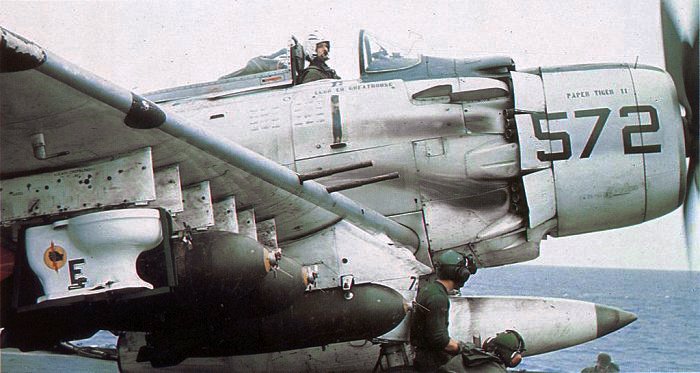In 1965, a US Skyraider took off from a US aircraft carrier en route to Vietnam. The aircraft was laden with ordnance to be dropped on the enemy, but, under the aircraft’s right wing was a rather unusual object, one that is usually on the receiving end of a different type of dropped ordnance, instead of being dropped itself. The object was a white toilet and it resulted in one of the most famous, and funniest photos to come from the Vietnam War.
Everything and the kitchen sink… or toilet
During the Vietnam War, aircraft carriers’ supplies were stretched so thin that aircraft would often leave for missions with only a half-load of ordnance to keep up the sortie rates. Many pilots objected to this, as loss rates were high (one aircraft per day was not unusual) and weren’t justified by the small bomb loads.
Despite this, pilots got creative with the empty pylons underneath their aircraft. On November 5, 1965, crews onboard the USS Enterprise (CVN-65) loaded up a ‘gift’ for the North Vietnamese to commemorate the 6 millionth pound of ordnance dropped during the war up to that point.
The gift was a toilet removed from the Enterprise. It was a faulty toilet and was due to be thrown overboard, but one of the pilots aboard the ship saved it and modified it so it could be carried and dropped from an aircraft. A nose section was added as well as tailfins on the back.
The toilet was attached to an A-1H Skyraider NE/572 “Paper Tiger II, ” from VA-25 “Fist of the Fleet”, flown by Commander Clarence W. Stoddard.
The Skyraider was a remarkable aircraft from a bygone era that managed to remain useful to the Air Force, Marine Corps, and the Navy for far longer than expected. The piston-powered aircraft first flew before WWII ended, but continued in service until the 1970s. The Skyraider was famous for the immense loads it could carry, even more than the B-17 Flying Fortress. In fact, its maximum take-off weight was close to that of a fully-loaded C-47.
Stoddard’s Skyraider, complete with the toilet, prepared to take off from the Enterprise, which was located at Dixie Station in the South China Sea. A number of Enterprise’s flight deck crew assumed positions that blocked the Captains view of the non-regulation object slung under the wings of 572.
As the aircraft was launched off the flight deck by the Enterprise’s catapult, a message came through the ship’s intercom: “What the hell was on 572’s right wing?”
Dropping the load
The Skyraider was headed to the Mekong Delta in South Vietnam. Once in the target area, Stoddard reeled off his list of ordnance to the forward air controller, ending with ‘and one code name Sani-flush.’
Accompanying Stoddard was Lieutenant Commander Robin Bacon in Skyraider NE/577. His aircraft was equipped with the fleet’s last wing-mounted film camera left over from WWII, which he would use to film the drop.
Stoddard released the toilet in a dive, which because of its inherently poor aerodynamics nearly struck his aircraft. After the drop, there were reportedly a lot of jokes about germ warfare.
Sadly Stoddard was killed a year later while flying 572. Three SAM missiles hit his aircraft while flying over Vietnam. He is immortalized by his toilet drop, one of the lighter moments in a dark time.
